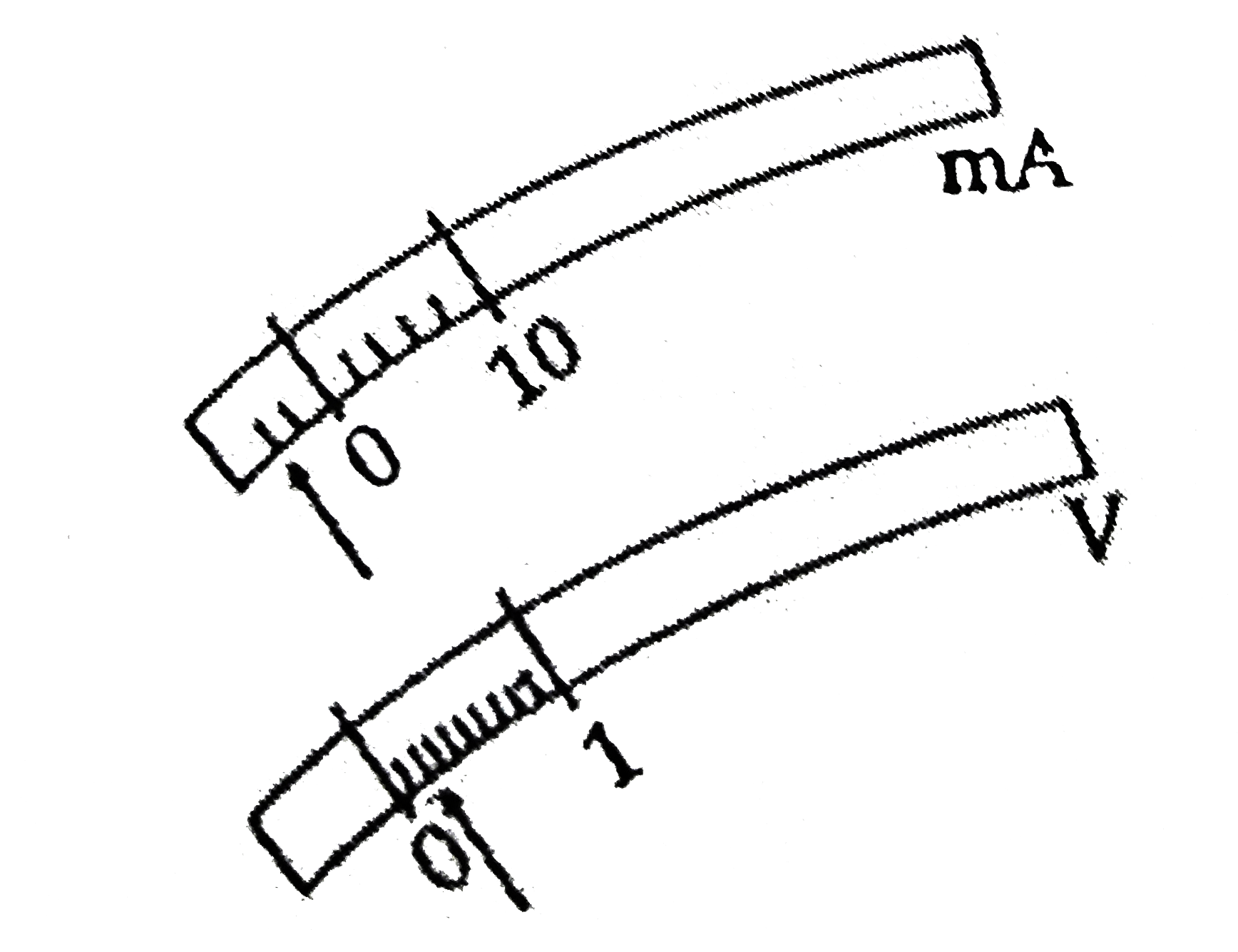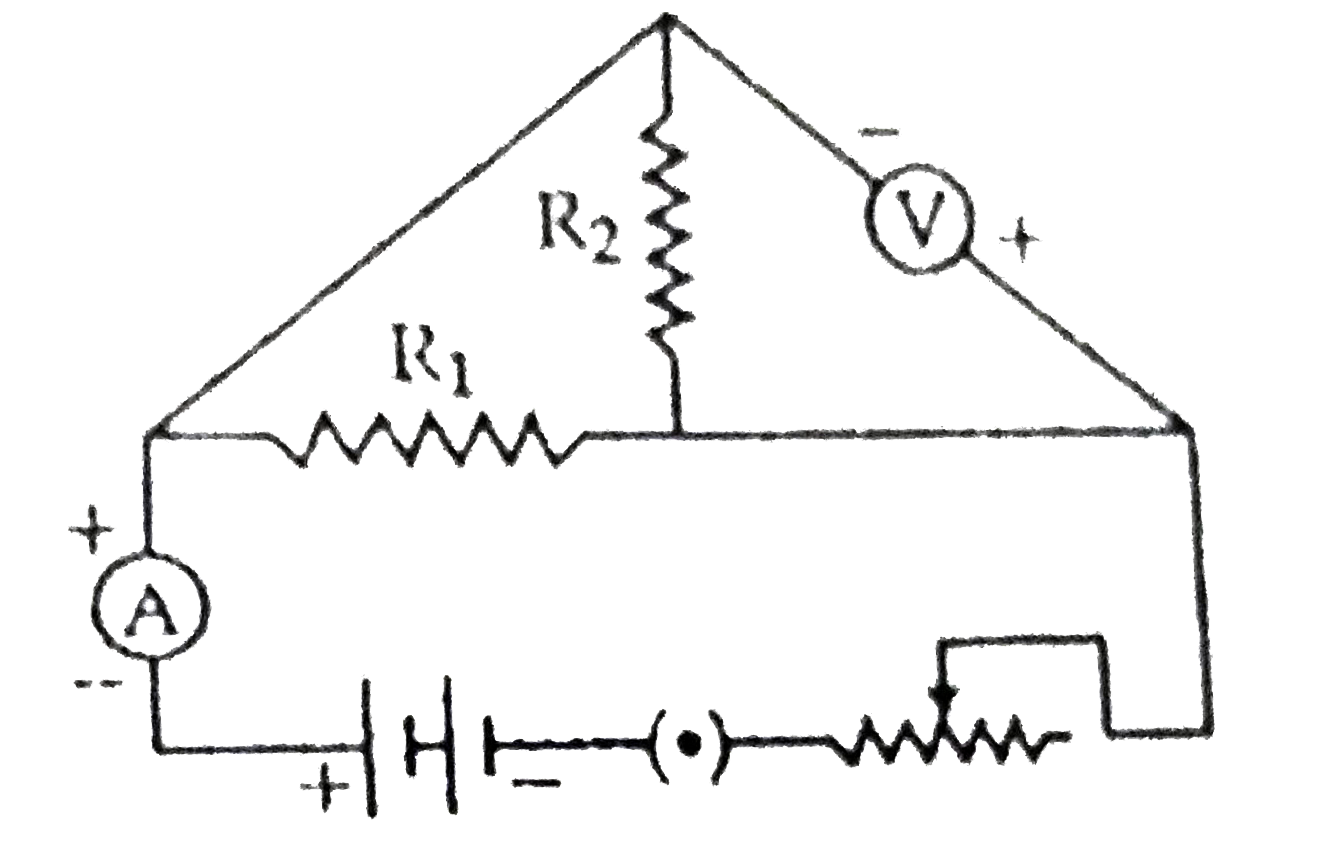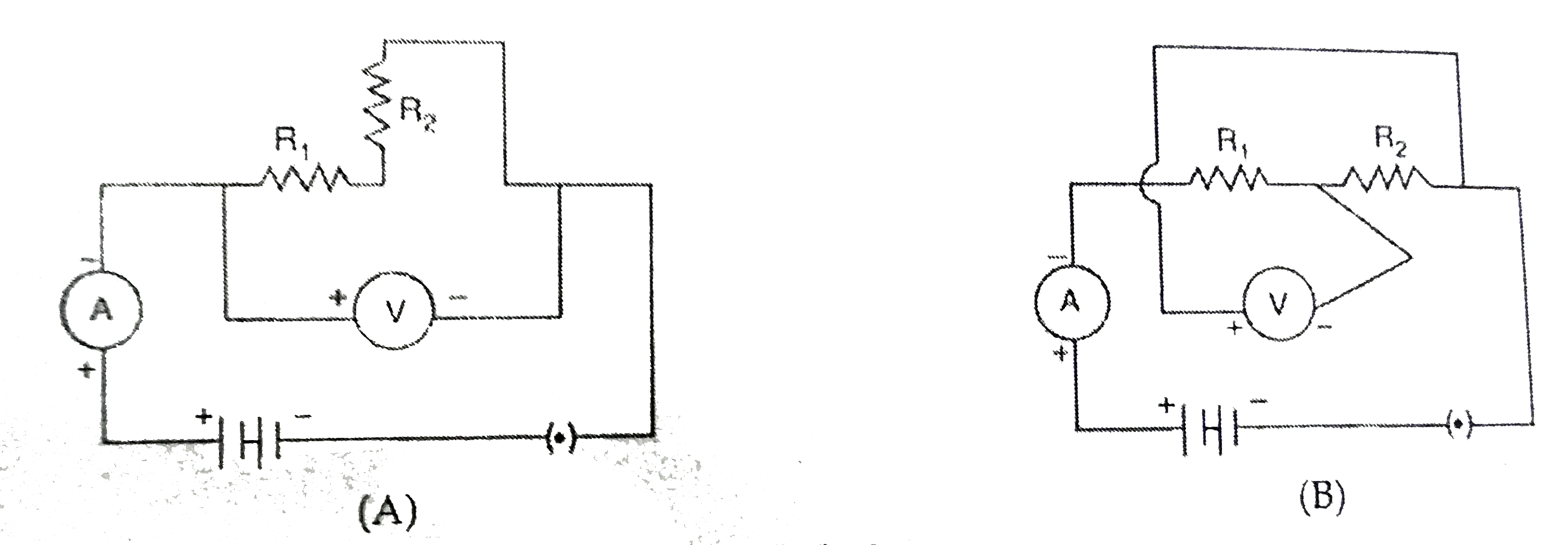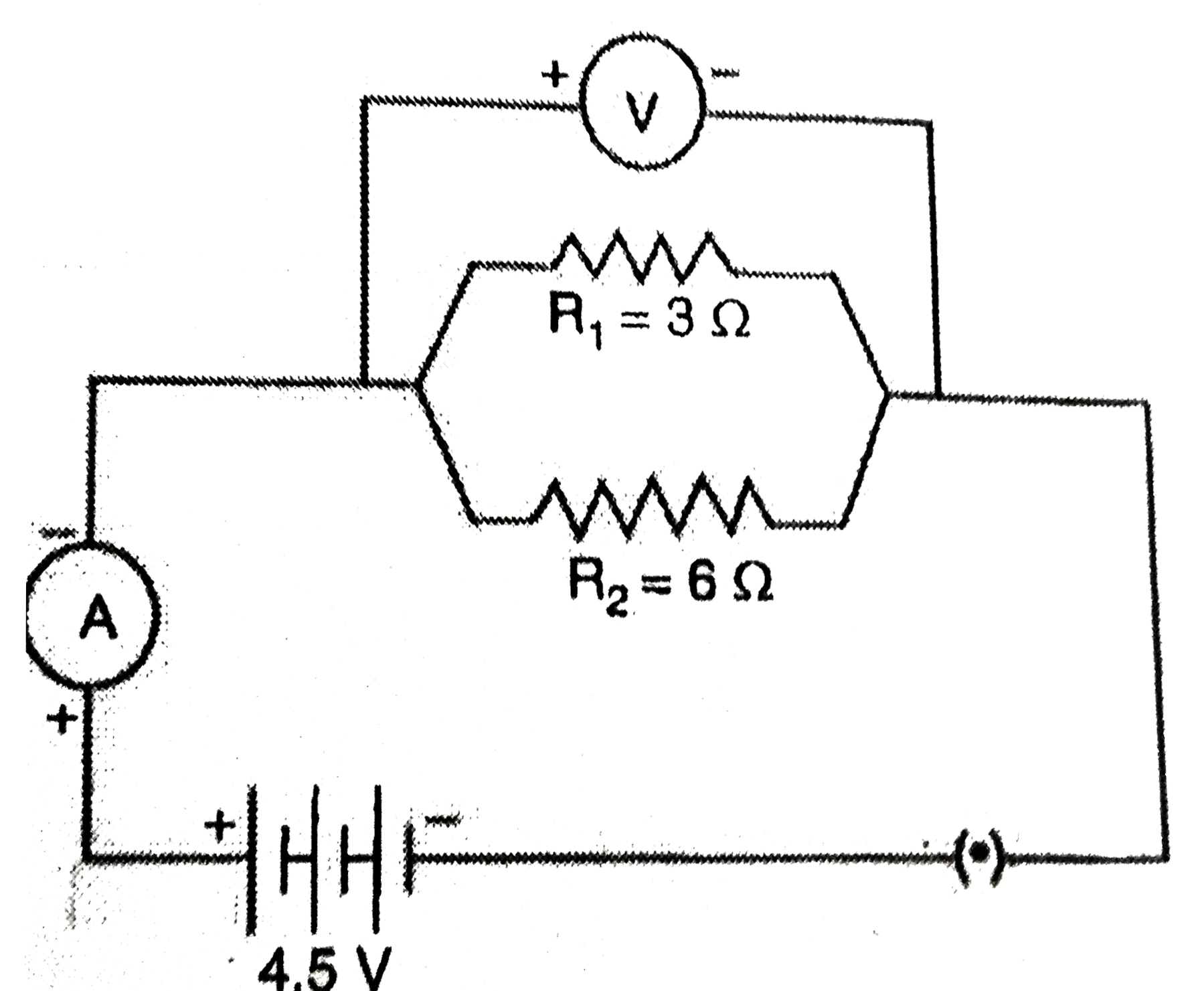Multiple Choice Questions from S CHAND PHYSICS Chapter 10 THE HUMAN EYE AND THE COLOURFUL WORLD for Class 10
| Class 10 | PHYSICS |
| Chapter | THE HUMAN EYE AND THE COLOURFUL WORLD |
| S CHAND PHYSICS | Multiple Choice Questions |
| Medium | English |
| Academic Year | 2023-2024 |
Question 10
The following 'precautions' were listed by a student in the experiment on study of 'Dependence of current on potential difference'.
(A) Use copper wires as thin as possible for making connections.
(B) All the connections should be kept tight.
(C) The positive and negative terminals of the voltmeter and the ammeter should be correctly connected.
(D) The 'zero error' in the ammeter and the voltmeter should be noted and taken into consideration while recording the measurements.
(E) The 'key' in the circuit, once plugged in, should not be taken out till all the observations have been completed.
The 'precautions' that need to be corrected and revised are :View SolutionQuestion 14
To study the dependence of current (I) on the potential difference (V) across a resistor R, two students used the two set ups shown in Figures A and B respectively. They kept the contact point J in four different positions, marked (a), (b), (c) and (d) in the two figures.

For the two students, the ammeter and voltmeter readings will be maximum when the contact J is in the position :View SolutionQuestion 22
To study the dependence of current (I) on the potential difference (V) across a resistor, two students used the two sets ups shown in figs (A) and (B) respectively. They kept the contact J in four different positions, marked (a), (b), (c), (d) in the two figures.

For the two students, their Ammeter and Voltmeter readings will be minimum when the contact J is in the position :View SolutionQuestion 24
The rest positions of the needles in a milliammeter and voltmeter not in use are as shown in (Fig. 3.61)(a). When a student uses these in his experiment, the readings of the needles are in the positions shown in (Fig. 3.61)(b). Find the corrected values of current and voltage in the experiment.
 .View Solution
.View SolutionQuestion 29
A student used the set up given here to study the dependence of current (I) on the potential difference (V) across a resistor.
He kept the contact C in four different positions marked as P,Q,R and S in the figure. On calculating the values of the ratio VI for his four readings, he would find that the value of this ratio :
 View Solution
View SolutionQuestion 39
While performing an experiment to determine the equivalent resistance of two resistors connected in parallel, a student observes the pointer of voltmeter at position X when the key is 'off' and the same pointer at position Y when the key is 'on'.

The correct voltmeter reading is :View SolutionQuestion 46
Two students (A) and (B) connect their two given resistors R1 and R2 in the menners shown below :

Student (A) connects the terminals marked (b1) and (C1) while student (B) connects the terminals marked (d2) and (c2) in their respective circuits at the points marked X and Y.

Which one of the following is correct in relation to above arrangements ?View SolutionQuestion 47
Three students (A), (B) and (C) connect their two given resistors R1 and R2 in the manners shown below :

They connect the terminals marked X and Y above to the terminals marked X and Y in the circuit given below:
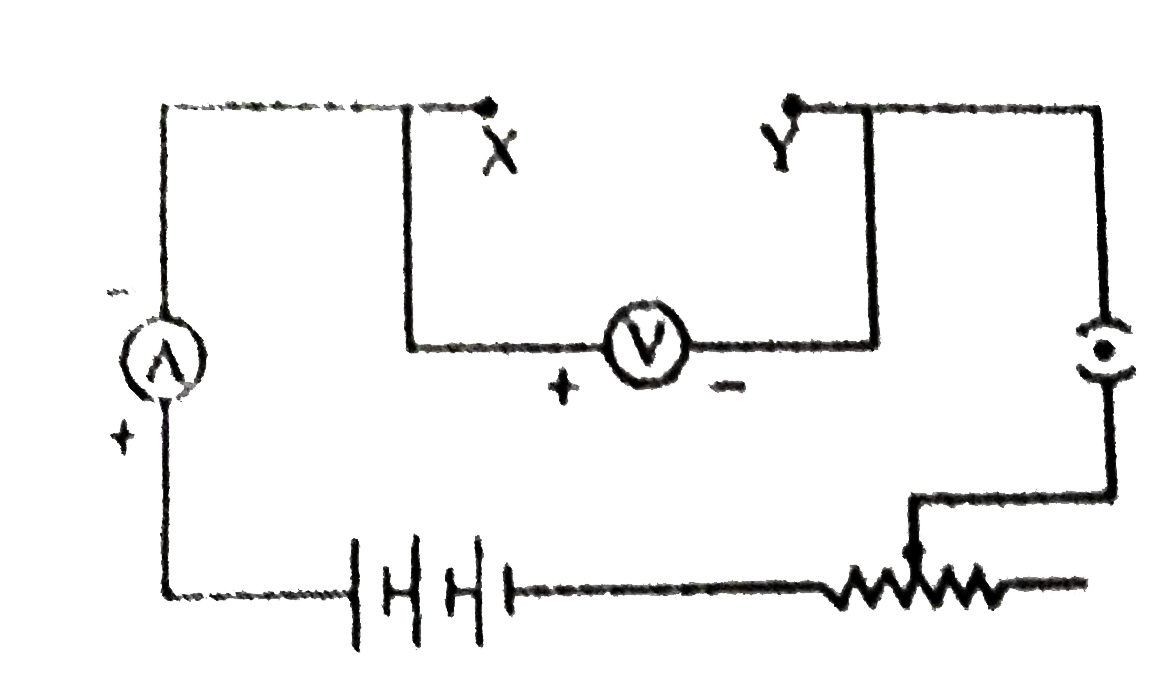
The record the Ammeter readings (I) for different positions of the rheostat and the corresponding Voltmeter readings (V).
The average value of the ratio V/I in their observations would be minimum for :View SolutionQuestion 49
A student carries out the experiment for studying the dependence of current (I) flowing through a resistor system of R1 and R2 on the potential difference (V) applied to it by connecting the resistor system to points X and Y of the measuring circuit as shown :

The average value of the ratio V/I, of his observations, would then be equalView SolutionQuestion 53
The values of resistance marked on the coils R1 and R2 are found to be correct. A student connects the given resistors in the following manner (as shown in Figure 1).

He then connects the terminals marked X and Y of the above combination of resistors R1 and R2 to the terminals marked X and Y in the circuit (shown in Figure 2).
The average value of the ratio V/I in the obervations recorded in the circuit would be :View SolutionQuestion 54
A student using the same two resistors, ammeter, voltmeter and battery, sets up two circuits A and B connecting the two resistors first in series and then in parallel.

If the ammeter and voltmeter readings in the two cases be I1,I2 and V1,V2 respectively, he is likely to observe that :View SolutionQuestion 59
To find the resultant resistance of two resistors when connected in series, a student arranged the various components according to the circuit shown alongside :
The student, however, did not succeed in his objective. Which of the following mistake has been made by the student in setting up the circuit ?
 View Solution
View SolutionQuestion 60
The following apparatus is available in a laboratory :
Battery : adjustable from 0 to 4.5V
Resistors : 3Ω and 6Ω
Ammeters : A1 of range 0 to 3 A , least count 0.1A
A2 of range 0 to 1 A , least count 0.05A
Voltmeters : V1 of range 0 to 10 V , least count 0.5V
V2 of range 0 to 5 V , least count 0.1V
Which is the best combination of votmeter and ammeter for finding the equivalent resistance of the resistors in series ?View SolutionQuestion 61
The following pieces of apparatus are available in a laboratory :
Battery : adjustable from 0 to 6 V
Resistors : 3Ω and 6Ω
Ammeters : A1 of range 0 to 5 A , least count 0.25A
A2 of range 0 to 3 A , least count 0.1A
Voltmeters : V1 of range 0 to 10 V , least count 0.5V
v2 of range 0 to 5 V , least count 0.1 V
For the experiment to find the equivalent resistance of the parallel combination of the two given resistors, which is the best choice ?View SolutionQuestion 67
Four students A, B, C and D performed the experiment to determine the focal length of a concave mirror by obtaining the image of a distant tree on a screen. They measured the distances between the screen and the mirror as shown in the diagrams given below :

The correct value for focal length will be obtained by the student :View SolutionQuestion 68
A student has to do the experiment on finding the focal length of a given concave mirror by using a distant object. Out of the following 'set-ups' A,B,C and D available to him:
A : a screen, a mirror holder and a scale
B : a mirror holder, a screen holder and a scale
C : a screen holder and a scale
D : a mirror holder and a scale
The 'set-up' which is likely to give him the best result is :View SolutionQuestion 69
Four student A,B,C and D performed an experiment to detemine the focal length of a concave mirror by using a lighted candle kept at a considerable distance as the object. They represented the position of image by drawing the following diagrams :
Which diagram describes the correct position of the image of the candle ?
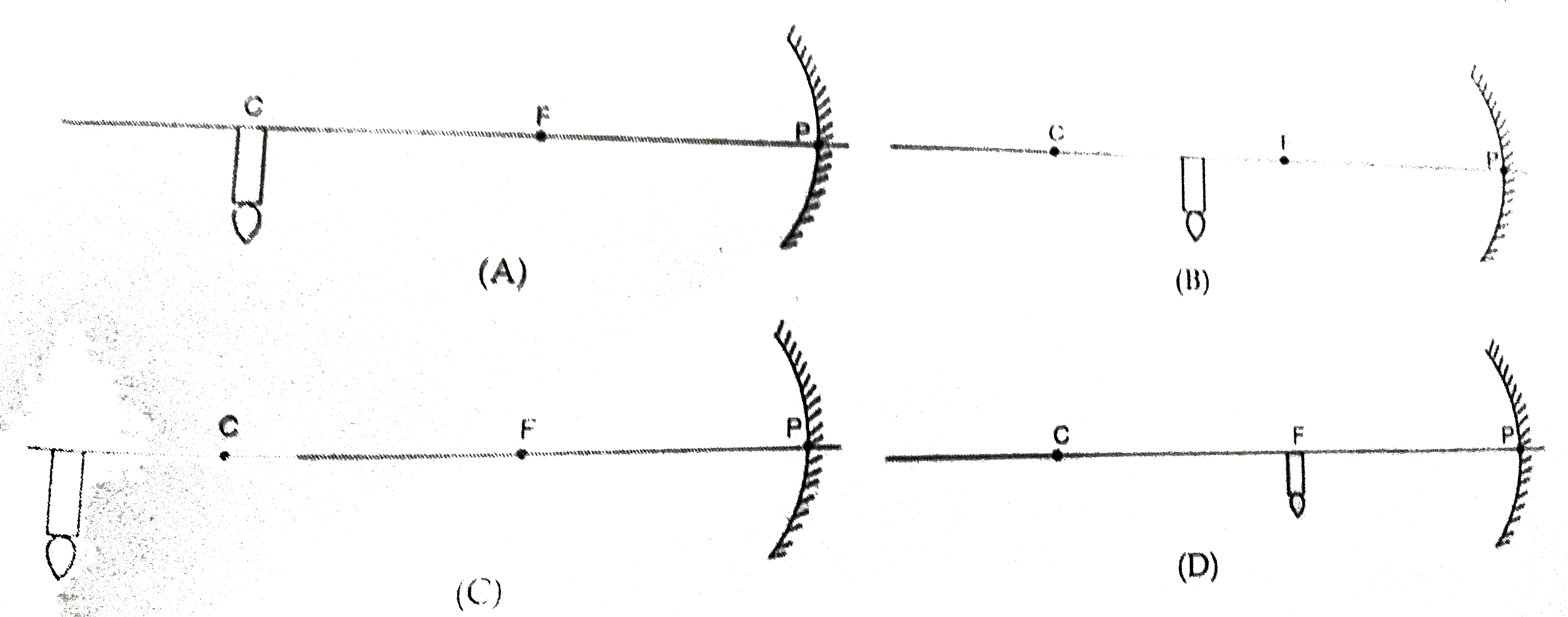 View Solution
View SolutionQuestion 71
In order to determine the focal length of a concave mirror, a student obtained a sharp image of the grill of a window in the laboratory wall on a screen. His teacher suggested that to get better result for focal length, he should focus a distant tree instead of the window grill. In which direction should the mirror be moved for for this purpose so as to get a sharp image of the tree on the screen ?View SolutionQuestion 73
A student performs an experiment on finding the focal length of a convex lens by keeping a lighted candle on one end of laboratory table, a screen on its other end and the lens between them as shown in the figure. The positions of the three are adjusted to get a sharp image of the candle flame on the screen.
If now the candle flame were to be replaced by a distant lamp on a far away electric pole, the student would be able to get a sharp image of this distant lamp on the screen by moving :
 View Solution
View SolutionQuestion 74
A student obtained a sharp image of the grill of a window in the laboratory on a screen, using a convex lens. For getting better results, her teacher suggested focussing of a distant tree instead of the grill. In which direction should the lens be moved for this purpose to get a sharp image on the screen ? View SolutionQuestion 76
While performing the experiment to detemine the focal length of a convex lens by using the sun as the distant object, a student could not find a screen with stand. In the absence of a good screen, which of the following method is the most appropriate and safe to be used by the student ?View SolutionQuestion 77
While performing an experiment on determining the focal length of a convex lens, a student obtains a sharp inverted image of the laboratory window grill on the screen and measures the distance between the screen and the lens. She then repeats the experiment and takes a distant tree as the object in the second case. In order to get a sharp image of the tree on the screen, she will now have to move the screen :View SolutionQuestion 79
A student was given the following suggestions by his classmates for performing the experiment on finding the focal length of a convex lens :
(A) Select any object very far away from the laboratory window
(B) Select a well illuminated object far (but not very far) from the laboratory window
(C) Keep all the lights of the laboratory on
(D) Place the lens between the object and the screen
(E) Place the screen between the object and the lens
(F) Obtain the sharpest image of the object on the screen
He can perform the experiment better by following the suggestions :View SolutionQuestion 81
A teacher gives a convex lens and a concave mirror of focal length of about 20 cm each to his student and asks him to find their focal lengths by obtaining the image of a distant object.The student uses a distant tree as the object and obtains its sharp image, one by one, on a screen. The distances d1 and d2 between the lens/mirror and the screen in the two cases and the nature of their respective sharp images are likely to be :View SolutionQuestion 82
Three students measured the focal length of a convex lens using parallel rays from a distant object. All of the measured the distance between the lens and the inverted image on the screen.
(i) Student A saw a sharp image on the screen and labelled the distance as f1
(ii) Student B saw a slightly larger blurred image on the screen and labelled the distance as f2
(iii) Student C saw slightly smaller blurred image on the screen and labelled the distance as f3
The relation between the three measurements would most likely be :View SolutionQuestion 85
Four students A, B, C and D performed an experiment to determine the focal length of a convex lens by using a lighted candle kept at a considerable distance as the object. They represented the position fo image by drawing the following diagrams :
Which diagram describes the correct position of image of the candle ?
 View Solution
View SolutionQuestion 86
A student performs the experiment on tracing the path of a ray of light passing through a rectangular glass slab for different angles of incidence. He measures the angle of incidence ∠i, angle of refraction ∠r and angle of emergence ∠e for all his observations. He would find that in all cases :View SolutionQuestion 88
A student suggested the following 'guidelines' to his friend for doing the experiment on tracing the path of a ray of light passing through a rectangular glass slab for three different angles of incidence :
A. Draw the 'outline' of the glass slab at three positions on the drawing sheet.
B. Draw 'normals' on the top side of these 'outlines' very near their left end.
C. Draw the incident rays on the three 'outlines' in directions making angles of 30∘,45∘,60∘ with the normals drawn.
D. Fix two pins vertically on each of these incident rays at two points nearly 1 cm apart.
E. Look for the images of the 'heads' of these pins while fixing two pins from the other side, to get the refracted rays.
When he showed these 'guidelines' to his teacher, the teacher corrected and modified the 'guidelines' labelled asView SolutionQuestion 95
Four students A, B, C and D selected the following items from the materials available in the science laboratory to perform an experiment to study the refraction of light through a glass slab :
(A) convex lens, glass slab, pins, drawing board, white paper, scale
(B) glass slab, pins, drawing board, scale, white paper, protractor
(C) glass slab, glass prism, candle, screen, pins, scale, drawing board, protractor
(D) concave mirror, pins, glass slab, protractor, white paper, drawing board
Correct choice of the items required is made by the student :View SolutionQuestion 96
In an experiment to trace the path of a ray of light passing through a rectangular glass slab, four students measured the angles of incidence (i), angles of refraction (r) and angles of emergence (e) as shown in the diagrams :

The correct measurement is given in the diagram :View SolutionQuestion 97
A teacher asked four students to record the observations of the experiment on tracing the path of a ray of light through a rectangular glass slab. The students recorded their observations under the following headings :
(1) Angle of incidence, Angle of refraction, Angle of reflection
(2) Angle of incidence, Angle of deviation, Angle of emergence
(3) Angle of incidence, Angle of reflection, Angle of emergence
(4) Angle of incidence, Angle of refraction, Angle of emergence
The correct observations were recorded by the student :View SolutionQuestion 99
A student traces the path of a ray of light passing through a rectangular glass slab for three different values of angle of incidence (∠i) namely 30∘,45∘ and 60∘. He extends the direction of incident ray by a dotted line and measures the perpendicular distance 'l' between the extended incident ray and the emergent ray. He will observe that :
 View Solution
View SolutionQuestion 101
In an experiment to study the refraction of light through a rectangular glass slab, a student measured the angle of incidence, angle of refraction and the angle of emergence, The student lost the reading of angle of incidence but noted the readings of angle of refraction to be 35∘ and angle of emergence to be 65∘. The angle of incidence is likely to be :View SolutionQuestion 102
In the glass slab experiment, a student measures the angle of incidence (∠i) in air and finds it to be 40∘. He also measured the corresponding angle of refraction as well as the angle of emergence for this ray of light but also their record. The most likely record of readings for the angle of incidence and angle of emergence wil be :View Solution




 :
:

